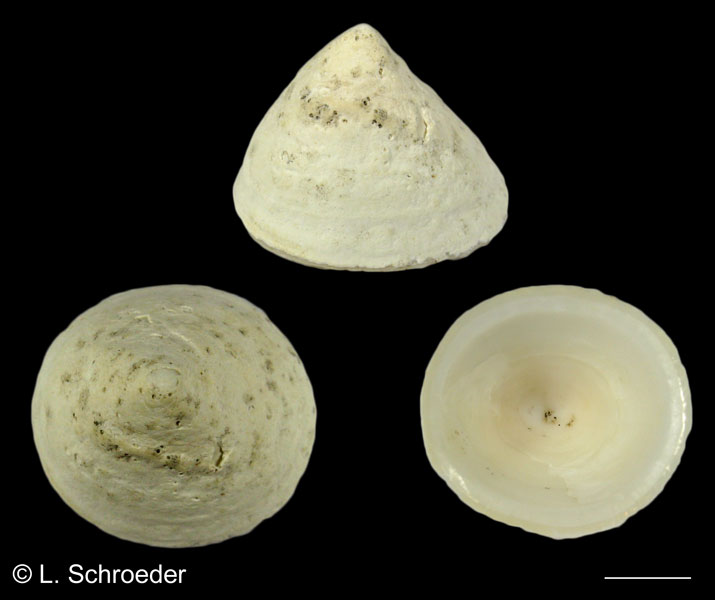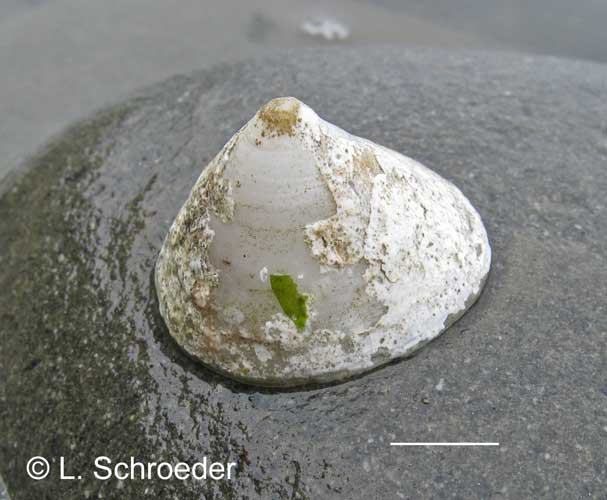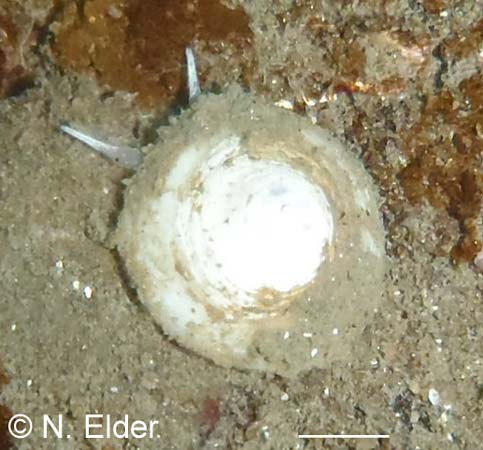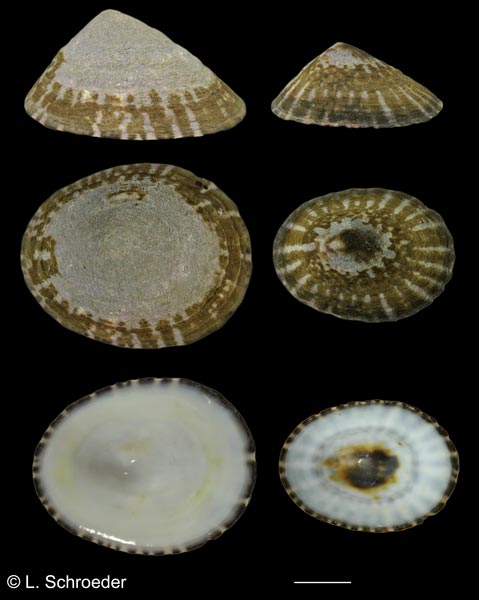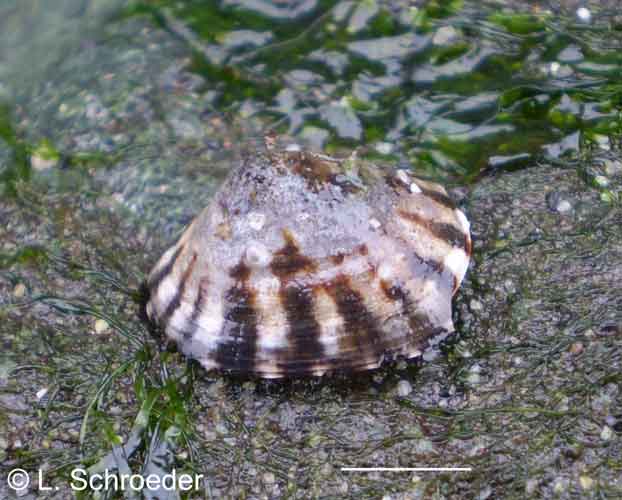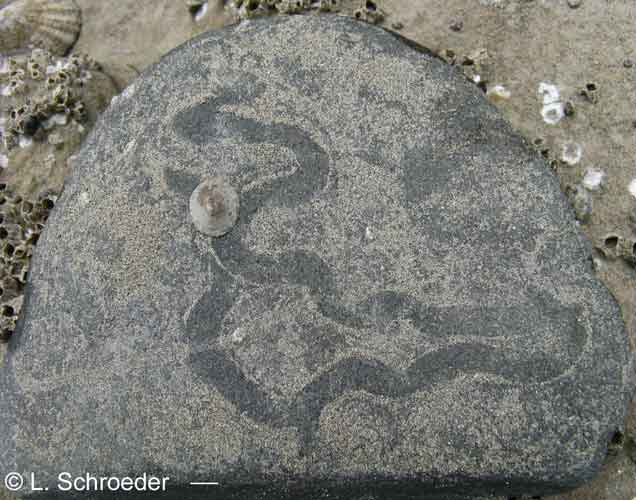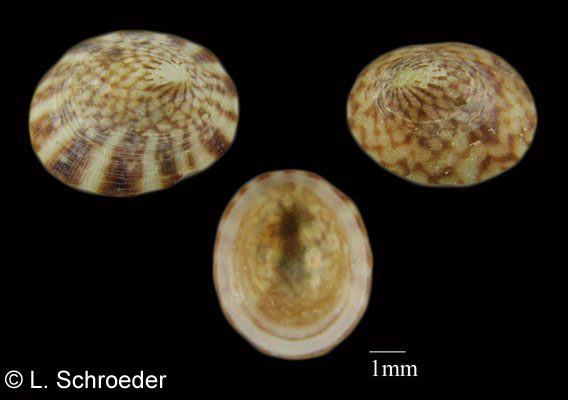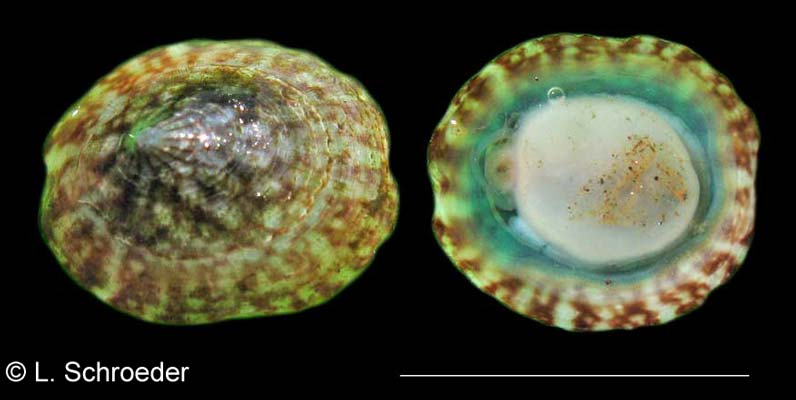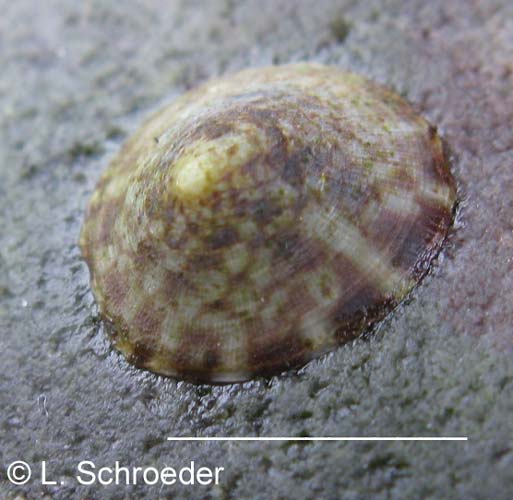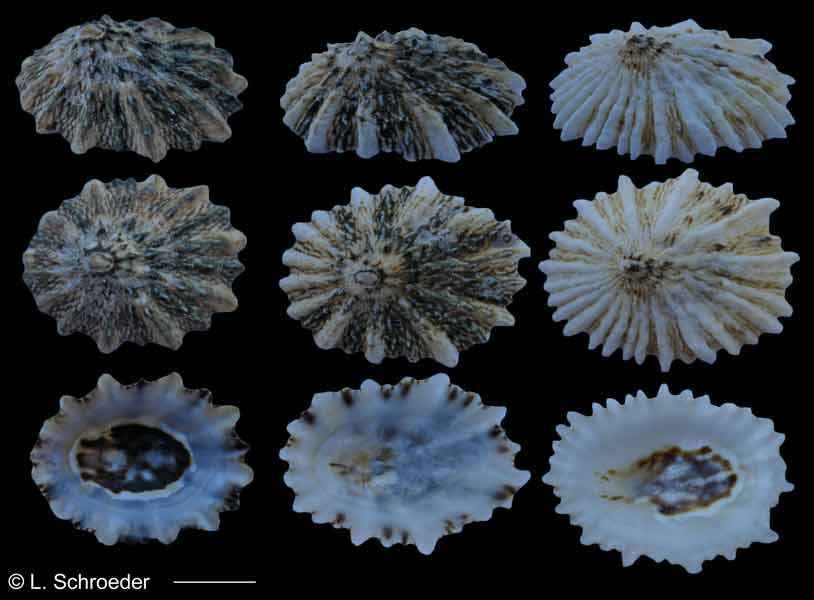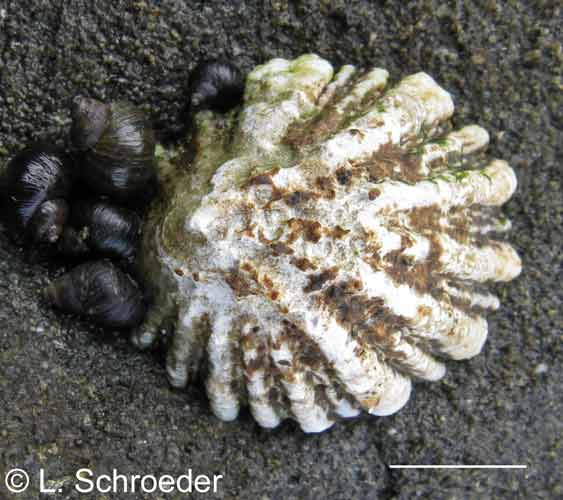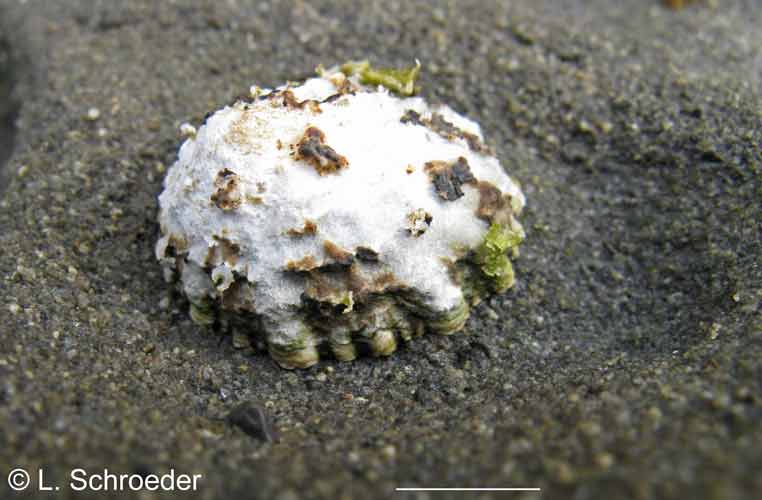Although the following species look like limpets, they are not closely related to the species above.
Click on photo to enlarge. Scale line in photo equals 1cm unless otherwise specified.
* Species which are commonly encountered on the beach.
Lepetidae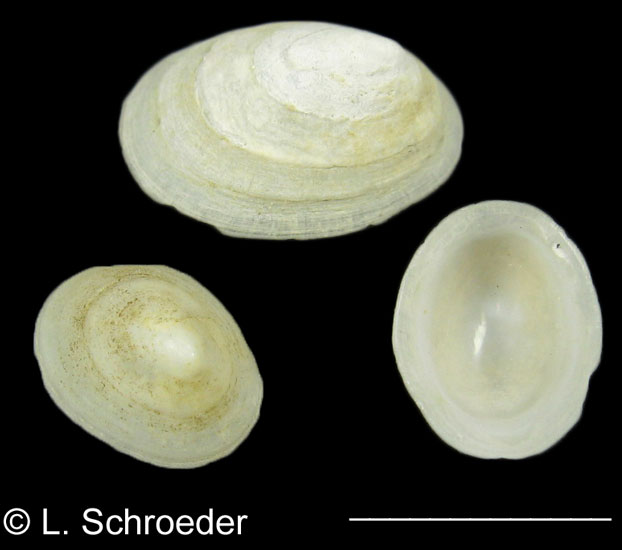
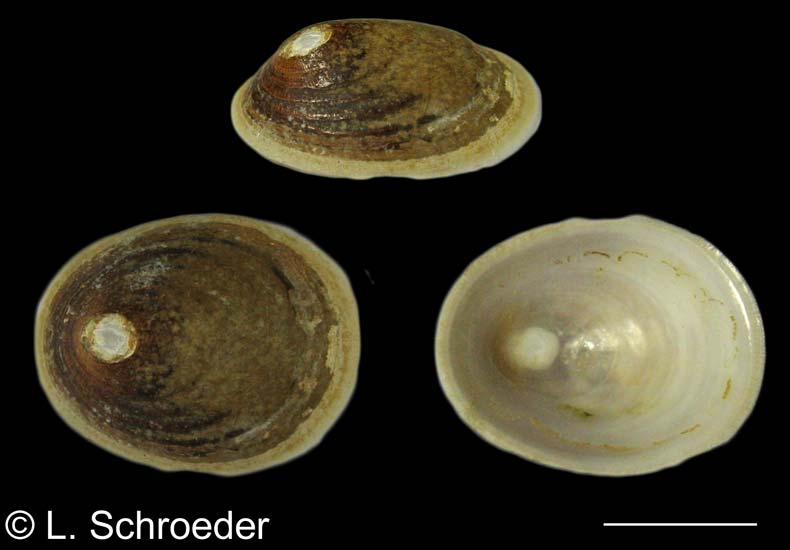
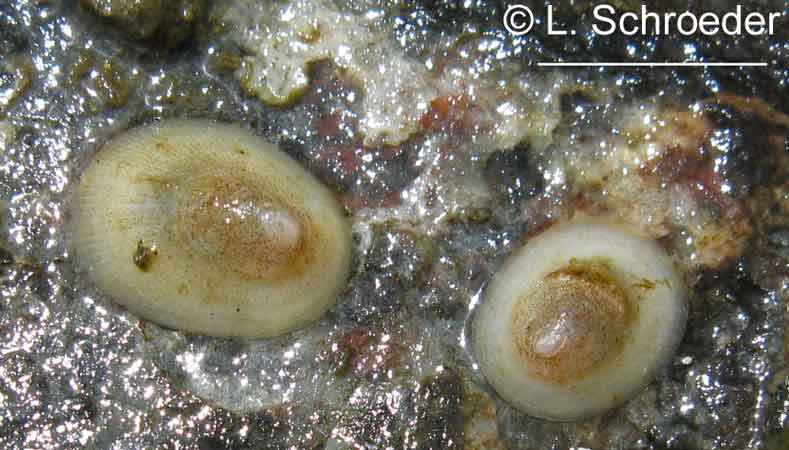
San Juan Islands, WA
Petersburg, AK, encrusted
extreme low
tide, Oak Bay, WA
Lepeta concentrica (Middendorff, 1848)Ringed Blind Limpetintertidal to 60m central California to northern Alaska size to 23mm
This
is infrequently found intertidally on the lowest tides. It is a white shell
with a low profile and may be encrusted, obscuring its color. There is
another small white limpet, Lepeta caeca, also rarely seen, which has small pustules on its shell which can distinquish it from this species.
(previous name - Cryptobranchia concentrica)
Acmaeidae
all specimens from area of Whiskey Creek Beach, WA intertidal
subtidal
Acmaea mitra Rathke, 1833
Whitecap Limpet *intertidal to 60m northern Mexico to northern Alaska size to 50mm
This can often be found on good low tides in rocky areas. Its tall conical profile is
unmistakeable. The shell is white but it is frequently encrusted
with white or red coralline algae. [all specimens shown are from
Whiskey Creek Beach, WA]
Gastropods
Family Acmaeidae, Lepetidae,
Lottiidae, Siphonariidae & Trimusculidae


Monterey Bay, CA
Cape Arago, OR, intertidal
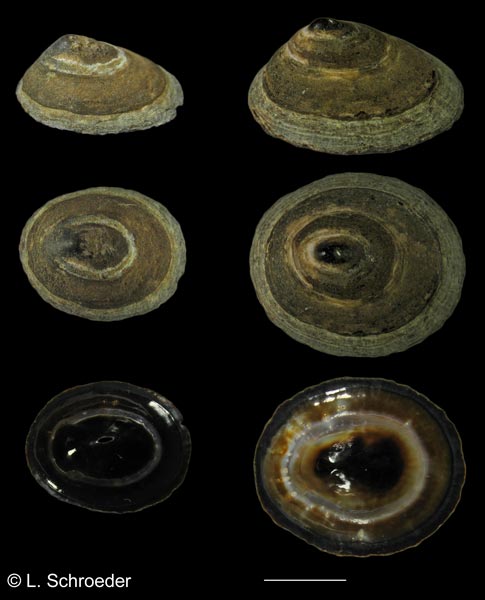
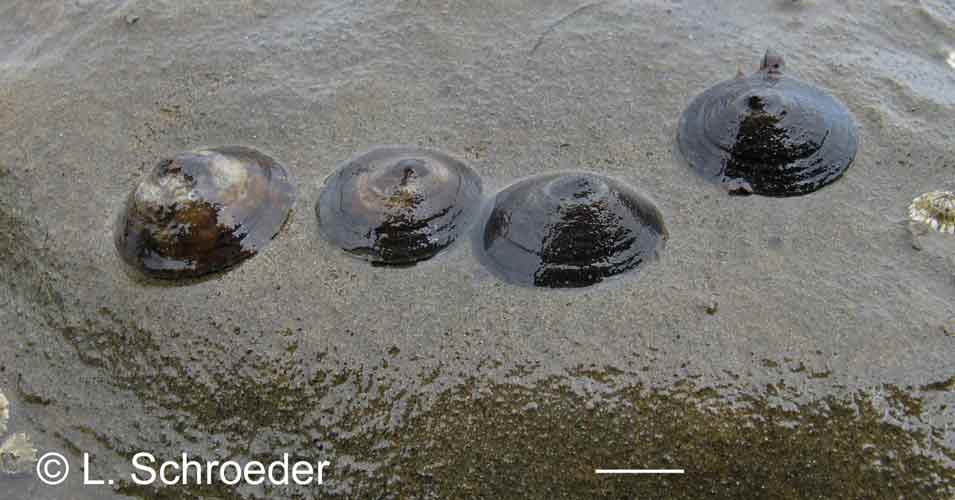
Yachats, OR
Whiskey Creek
Beach, WA, intertidal
Lottia fenestrata (Reeve, 1855)Fenestrate Limpet or Chocolate Limpet
intertidal northern Mexico to Alaska size to 26mm
This
species is infrequently found. It lives in the lower intertidal
zone and is usually found at the base of rocks burrowed
into the sand at low tide. The top of the shell is usually
eroded and it can be difficult to identify without seeing the interior
of the shell. The interior may be a solid dark chocolate brown to
a lighter brown with only a dark lower ring. The apex is slightly off center.
(previous names - Tectura fenestrata, Notoacmaea fenestrata, Collisella fenestrata, Acmaea fenestrata, Acmaea cribraria)
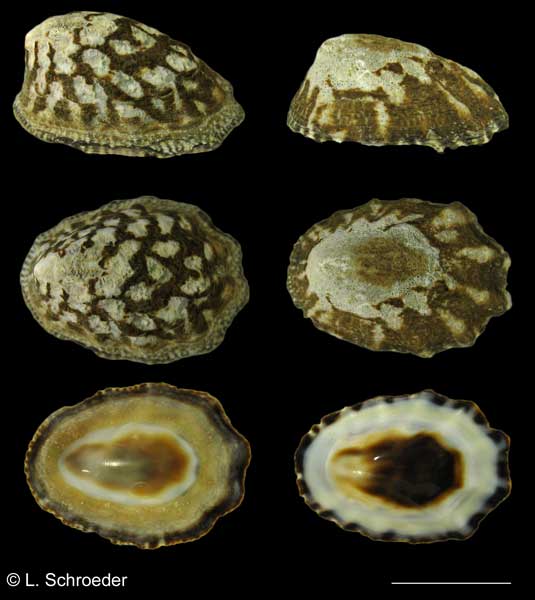
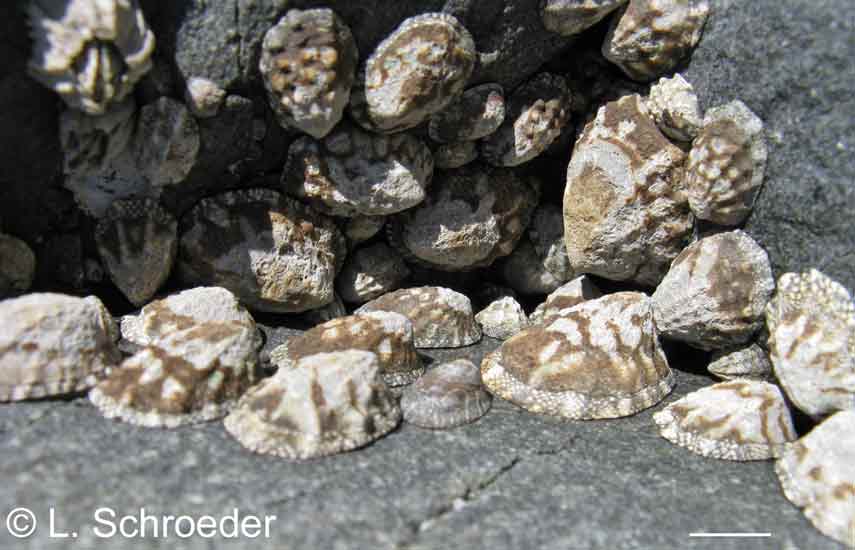
all Deception Pass, WA
intertidal
Lottia digitalis (Rathke, 1833)
Ribbed Limpet or Finger Limpet *high
intertidal northern Mexico to
northern Alaska size to 35mm
This is commonly found in the higher intertidal zone. It lives among the barnacles. The apex is far forward
on the shell and it has distinct ridges. It is generally patterned with brown markings and spots. This species
is hard to confuse with any other in our area.
(previous names - Collisella digitalis, Acmaea digitalis, Collisella austrodigitalis, Acmaea radiata)
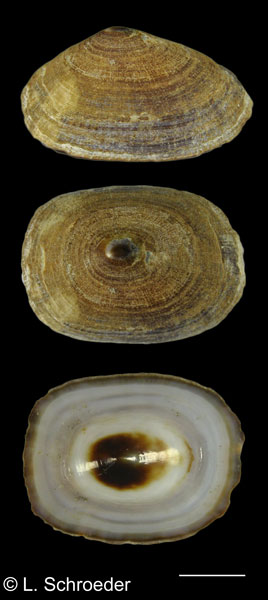
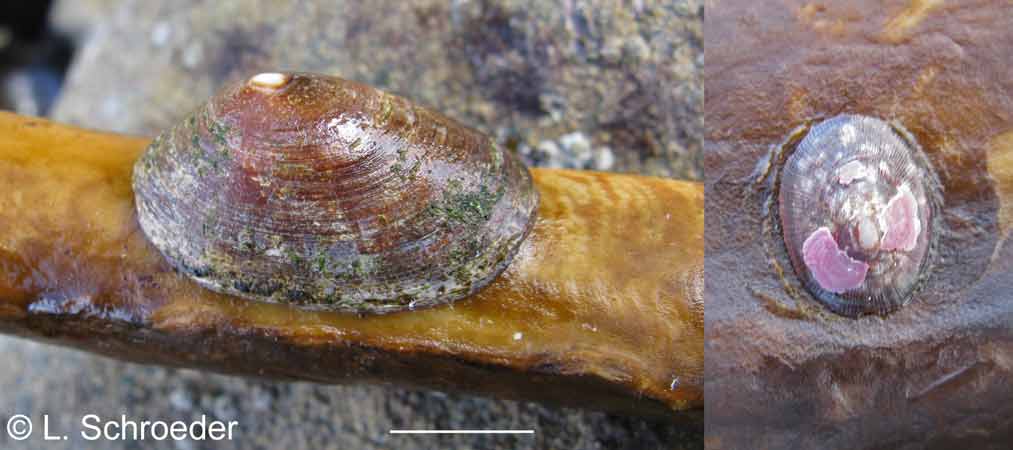

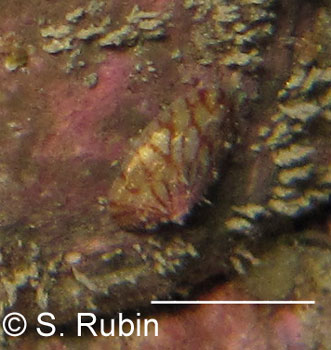
Whiskey Creek Beach, WA
Slip Point, WA, intertidal
Port Angeles, WA, subtidal Freshwater Bay, WA, subtidal
kelp morph
kelp morph
kelp morph
rock morph
Lottia instabilis (Gould, 1846)
Unstable Limpet *intertidal
to 73m southern California to
northern Alaska size to 35mm
This
species is generally easy to find, although it is usually as a dead
shell washed ashore. The most recognizeable form of this species
has a distinct oval shape and high profile. It lives on the
stipes of kelp and is frequently encrusted with coralline algae.
This species also has an ecomorph which
lives on rocks
or shells. The rock morph is difficult to separate from the
other common intertidal species as it exhibits similar patterned
markings and profile, although it has parallel sides. The rock
morph used to be described under the name Lottia ochracea.
(previous names - Notoacmaea instabilis, Collisella instabilis, Acmaea instabilis)
Lottia asmi (Middendorff, 1847)
Black Limpet
intertidal size to 10mm
northern Mexico to southern Alaska
This species is hard to find. It generally lives on the shell of the Black Turban, Tegula funebralis, but not exclusively. The color of the limpet blends with the color of turban shell.
(previous names - Collisella asmi, Acmaea asmi)
Petersburg, AK
Marrowstone Is., WA
Whiskey Creek Beach, WA, feeding trail
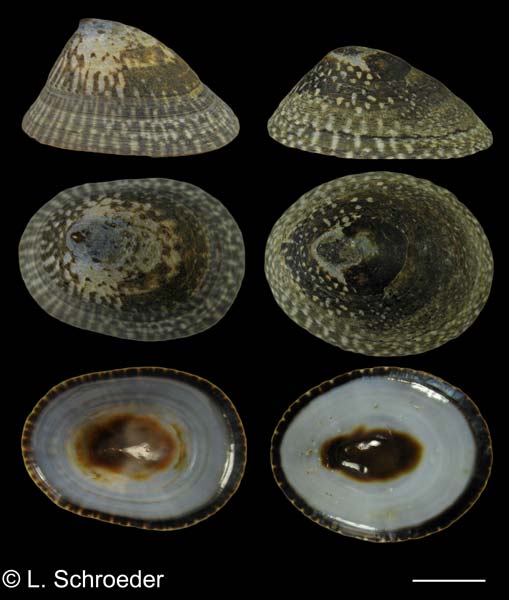
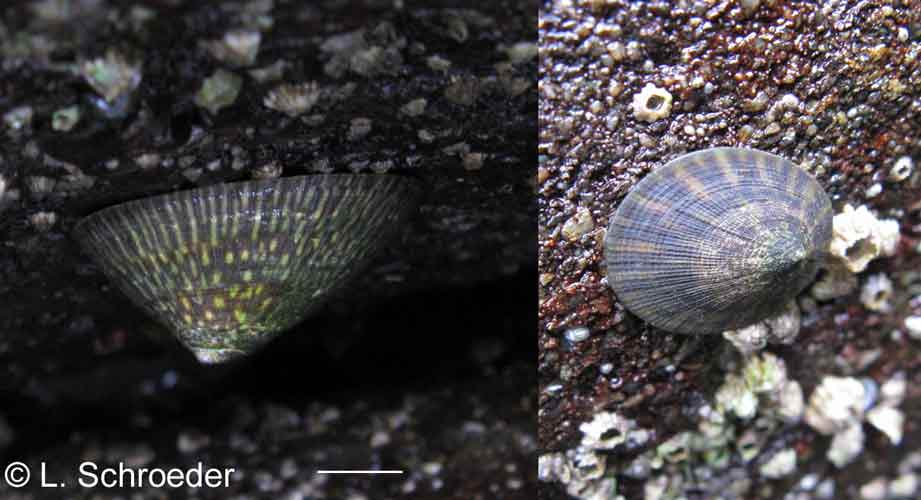
left - Petersburg, AK, right - Yachats, OR
Waldron Island, WA, intertidal
Lottia persona (Rathke, 1833)
Mask Limpet *high
intertidal northern Mexico to
northern Alaska size to 50mm
This is a very commonly found species. It lives in the very high intertidal zone. The interior may be white to
bluish with a dark band at the base. The exterior may have varying amounts of patterning. Juveniles often
show faint radial ribs, but these become obscured on older specimens. The shell also becomes significantly
higher as it ages. These shells are rarely obscured by algae or other overgrowth. As with many limpets,
their shape, height and coloration may be affected by their habitat. They can be mistaken for Lottia pelta but these live much higher in the intertidal.
(previous names - Tectura persona, Notoacmaea persona, Acmaea persona, Collisella radiata)
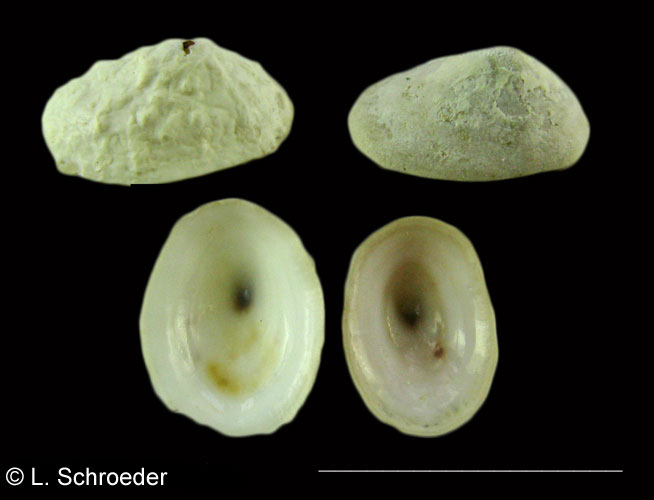 Barkley Sound, BC
Barkley Sound, BC
Lottiidae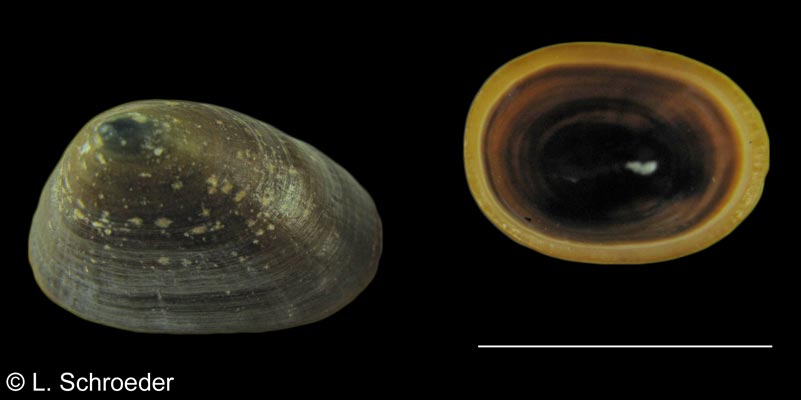
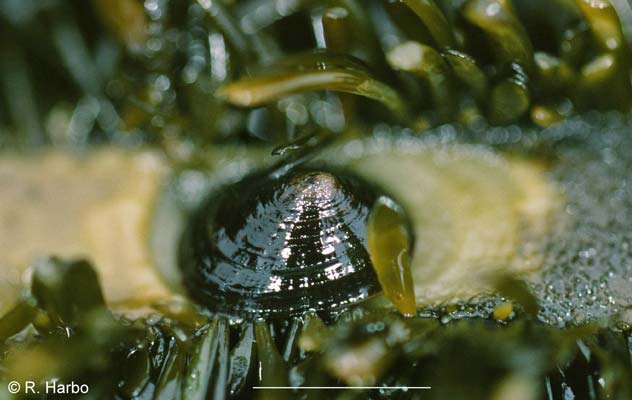
Monterey, CA
Monterey, CA, intertidal
Discurria insessa (Hinds, 1842)Seaweed Limpet
intertidal northern Mexico to southern Alaska size to 22mm
This
species is hard to find. It feeds on the feather boa kelp but is
very difficult to spot. It has a relatively smooth brown surface
and is difficult to confuse with any other species.
(previous names - Notoacmaea insessa, Collisella insessa, Acmaea insessa, Patella insessa)
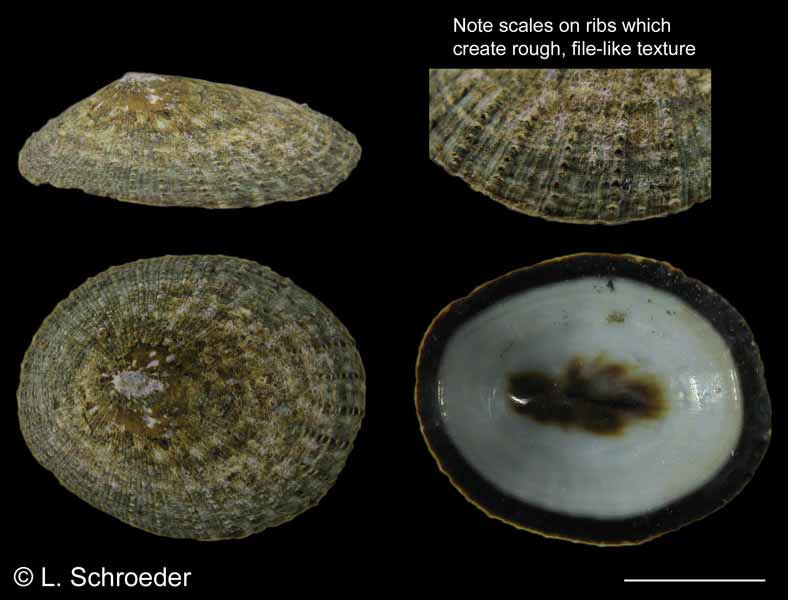 Long Beach, CA
Long Beach, CA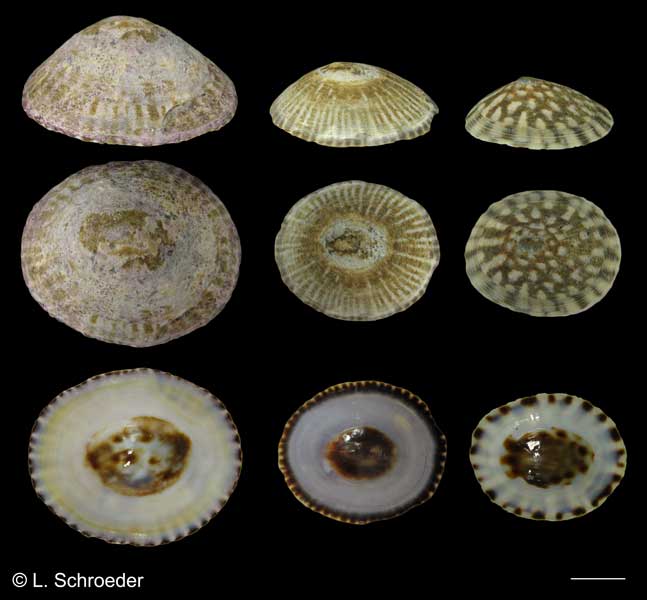
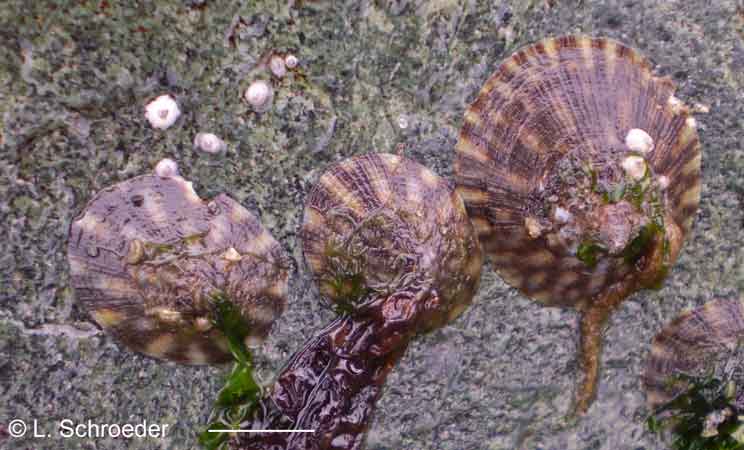
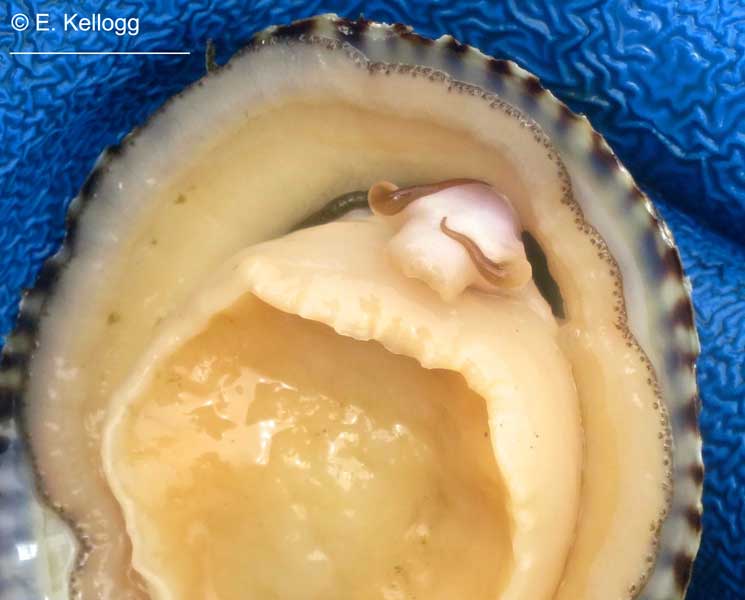
left-Petersburg, AK; center-Slip Point, WA;
Marrowstone Island, WA, intertidal
Slip Point, WA, note the brown
tentacles
right-Deception Pass, WA
Lottia scutum (Rathke, 1833)
Pacific Plate Limpet *intertidal to shallow subtidal northern Mexico to northern Alaska; Japan; Siberia size to 64mm
This is a very common species. It is very similar in appearance to L. pelta but usually a little lower in the intertidal.
This shell has a rather brittle outer edge.
The tentacles of the animal are brown which also distinguish it
from our other limpets whose tentacles match the
animal's body color.
It is typically low in height but may grow quite large and high in some habitats. The shell surface is often covered
in algae.
(previous names - Tectura scutum, Notoacmaea scutum, Acmaea scutum, Acmaea testudinalis scutum)
Lottia limatula (Carpenter, 1864)File Limpet
intertidal northern Mexico to southern BC size to 50mm
This
species is rare to find in the Pacific Northwest. North of
central Oregon, it has only been found around southern Vancouver Island
in BC. The scales along the ribs are its identifying feature,
although the scales can be worn nearly smooth. It prefer the
outer coast or high current areas.
[see article on finds in BC]
(previous names - Collisella limatula, Acmaea limatula)
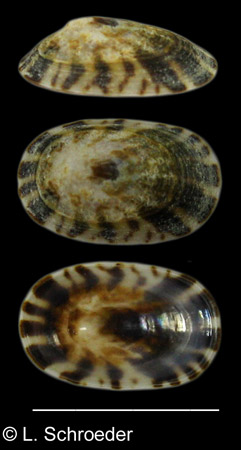
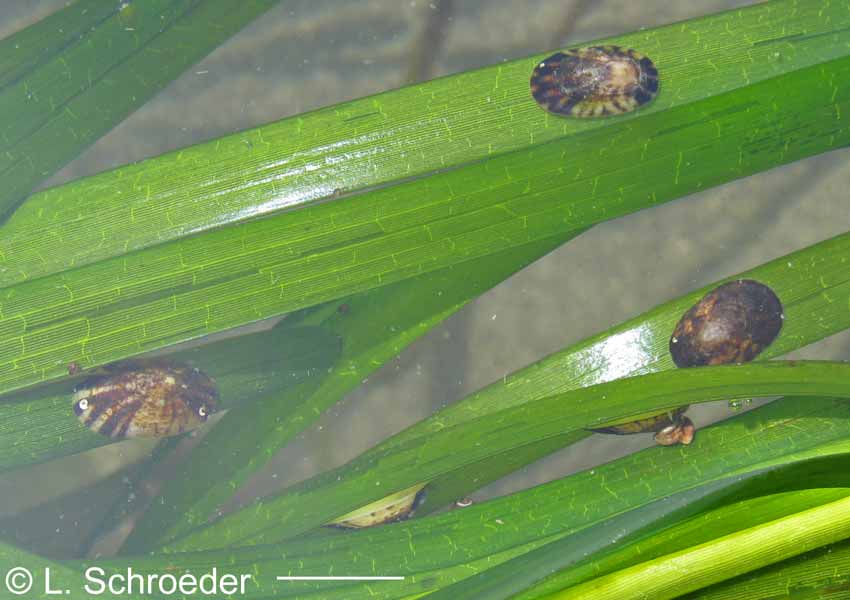 Boundary Bay, BC
Birch Bay, WA, intertidal
Boundary Bay, BC
Birch Bay, WA, intertidal
(This eelgrass form previously known as Lottia parallela.)
Lottia pelta (Rathke, 1833)
Shield Limpet *
intertidal
northern Mexico to northern Alaska;
Siberia size to 54mm
This is a
very common species and is one of our most abundant limpets. It
has a highly variable shape and coloration depending on its habitat.
It generally has a high apex, slightly forward on the
shell. The shell is normally narrower toward the front. When not highly eroded by waves or encrustations, it exhibits
radial ribbing. The color may be light to dark with radial
banding. The
shell is frequently covered by
algae or encrustions or is eroded. This species
may have several ecomorphs. Preliminary studies have shown that
the Pacific Eelgrass Limpet, Lottia parallela, is simply an ecomorph of Lottia pelta.
(previous names - Collisella pelta, Acmaea pelta, Acmaea cassis, Acmaea olympica, Acmaea nacelloides)
Lottia triangularis (Carpenter, 1864)
Triangular Limpet
low intertidal to subtidal California to BC? size to 8mm
This species is rarely seen. There are two forms. The elongated
form is shown here and it is often white and encrusted with coralline algae. A more compressed, wider form lives on the stipes of
corallines and exhibits more markings.
Trimusculidae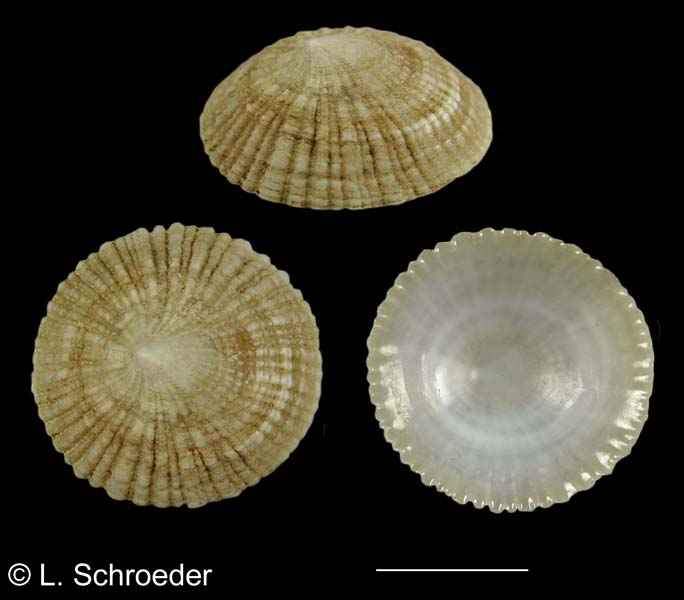
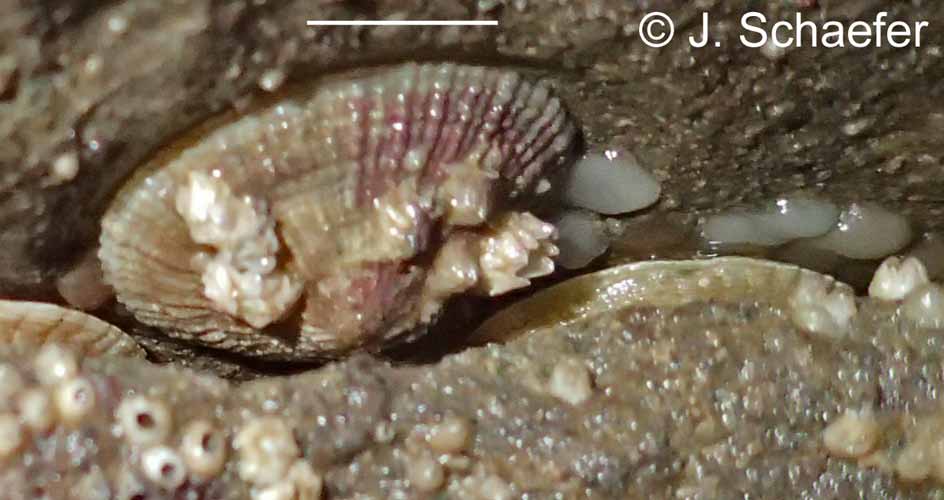
Coos Bay, OR
Coos Bay, OR,
intertidal in cave, with eggs
Trimusculus reticulatus (Sowerby, 1835)Reticulate Button Snail
very high intertidal Chile; northern Mexico to northern Washington size to 20mm
This species is very rare to find. It lives in crevasses and caves.
This is an air breather, spending most of its time out of the water.
(previous name - Gadinia reticulata)
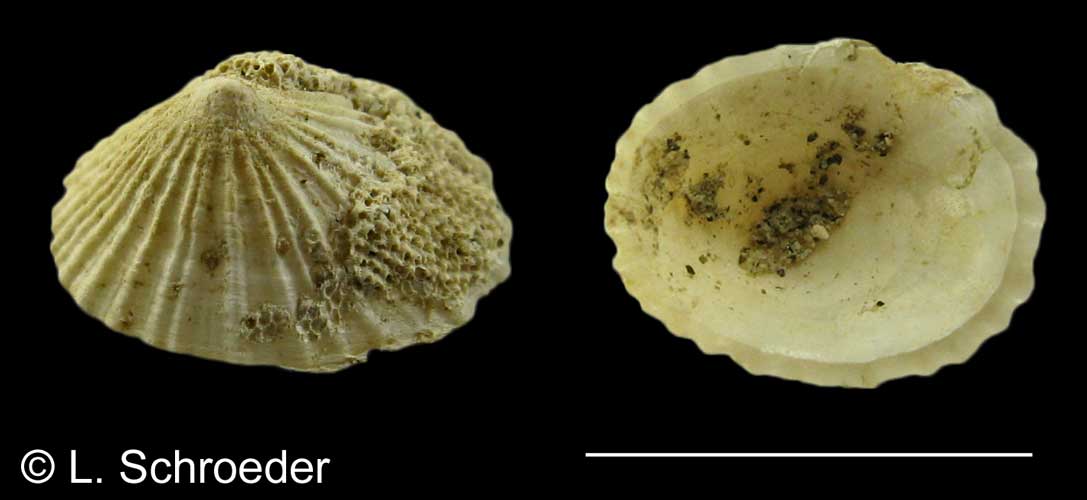
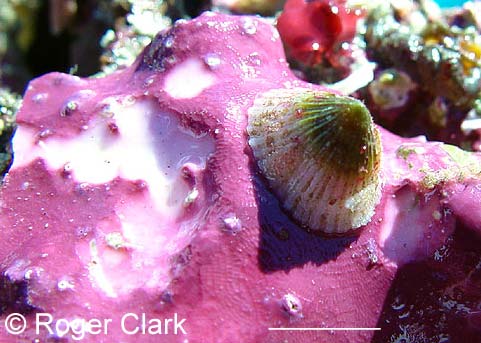
Carmel
Bay, CA
off San Pedro, CA, subtidal
Acmaea funiculata (Carpenter, 1864)
Corded White Limpet
subtidal, 15-70m north Mexico to central Alaska size to 25mm
This
species is generally only seen by divers. Often it is heavily
encrusted by other organisms and hard to spot. A dead shell might
easily be confused with some of our keyhole limpets with similar corded
exteriors. The lack of a hole near the apex would identify this
species. The interior may be pink in color when it's been
feeding on coralline algae.
(synonym - Niveotectura funiculata)
This page last revised: 1-21-2025



